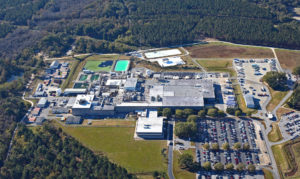
Nuclear Regulatory Commission Issues Environmental Impact Statement on Westinghouse Nuclear Fuel Plant, Fails to Justify 40-Year Operating License Extension for Troubled Facility
Columbia, SC – After years of delays due to citizen protest, operating problems and revelations of groundwater contamination with chemical and radioactive materials, the U.S. Nuclear Regulatory Commission (NRC) today issued the final Environmental Impact Statement (EIS) for the Westinghouse nuclear fuel plant located near Columbia, South Carolina. The EIS was prepared as part of the company’s request, originally, in 2014, to extend its operating license for an additional 40 years
The Westinghouse plant, which began operation in 1969, makes fuel rods made from enriched uranium for commercial nuclear power plants in the U.S. and abroad. Over its many years of operation, the facility has been plagued with a long list of accidents and “events” – such as worker exposure, facility contamination and risk of nuclear criticality – as well as chronic groundwater contamination with radioactive materials and chemicals.
Disputed by members of the public at many meetings over the last few years, the EIS admits that “future inadvertent releases of contaminants to the subsurface are reasonably foreseeable,” (page xv) and that “the cumulative impacts to groundwater and surface water from past and current CFFF operations are MODERATE,” yet the NRC went ahead and recommended a 40-year license extension.
The NRC makes the absurd claim that environmental impacts of operation of the facility for 40 additional years versus an additional 20 years would be similar: “The NRC staff found that the potential environmental impacts from this alternative would be similar to the potential impacts from the proposed action except that the impacts would occur over a shorter timeframe.” (page xvi) This statement, which was in earlier documents and which was challenged by the public, is revealed to be ridiculous and misleading given that incident, events, and accidents regularly occur and are likely to increase as the facility ages.
According to Tom Clements, director of the public-interest group Savannah River Site Watch, who has monitored the Westinghouse facility for decades, the EIS is inadequate and does not justify the recommended 40- year extension of the operating license. “It has been clear from the start of the license renewal process that the NRC was going to do what Westinghouse requested in spite of a long list of incidents at the facility and even an admission by the NRC that release of contaminants in the future was reasonably foreseeable,” said Clements. “The 40-year license extension guarantees the risk of accidents and releases that will impact the environment and possibly human health over 40 years. Unfortunately, I now anticipate that careful behavior shown by Westinghouse during the period of the EIS preparation will now be relaxed as Westinghouse is essentially now being given a license to pollute. The NRC should reconsider its recommendation and in the formal decision on the license period that is soon to come a 20-year license, at most, should be issued,” added Clements.
Full SRS Watch news release of July 29, 2022 posted here: SRS Watch news on release of Westinghouse EIS by NRC July 29 2022
Update, September 12, 2022: The NRC has still not published the formal “Record of Decision,” which would make official the 40-year license extension, in the Federal Register. A ROD is usually published 30 days or more after an EIS is formally “noticed” in the Federal Register. The publication of the Westinghouse EIS by the NRC was in the August 5, 2022 Federal Register: https://www.govinfo.gov/content/pkg/FR-2022-08-05/pdf/2022-16627.pdf
Photo of Westinghouse fuel plant by High Flyer